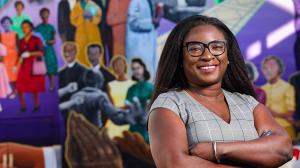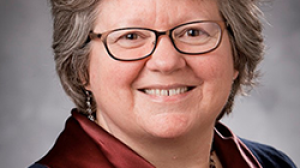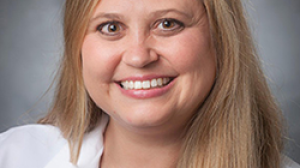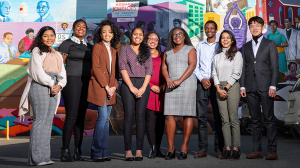Dissecting Disparities in Cancer Outcomes
When Tomi Akinyemiju, PhD, came from Nigeria to the United States — Michigan, to be precise — for college in 2001, the first thing she realized was that she had drastically underestimated the cold. “It was the first snowstorm of the winter,” she said. “I arrived in Michigan wearing a cute little hoodie, thinking I was all bundled up.” Her brother, who had been living in the state for a while, brought her a winter jacket.
A bit later, when she applied for a part-time job, she found it odd that the application asked her to check a box to indicate her race. In Nigeria, where she had lived since she was 3 years old, she had never had to think about her race. “Why does it matter what race I am?” she thought.
As it turns out, it matters a lot. “The more time I spent in the United States, the more I understood that there are complex historical, structural and systemic factors that shape everyday interactions,” she said. “The moment you step outside your door, one of the first things people notice is your race. And with that comes a series of unspoken and complex social cues to negotiate and navigate any preconceived assumption and implicit association, and to get to present your true self. Sometimes it is an uphill battle.”
Race, and how people are treated differently because of it, leads to major differences in health outcomes for cancer and other diseases. As a bit of an outsider, Akinyemiju (pronounced Ah-keen-yah-MEE-jew) saw this aspect of culture and health as something to be examined and dissected. She has built her career doing that.
A social and molecular cancer epidemiologist, Akinyemiju meticulously studies what drives cancer outcomes in populations in the United States and across the globe, trying to understand why some groups of people fare worse than others, and what can be done to erase those disparities.
The Stress of Systemic Racism
In the United States, African Americans and Hispanics tend to have poorer cancer outcomes compared to white patients. For instance, Black people with lung cancer are more likely to die than whites with the disease. In ovarian cancer, survival rates for white women have increased since the 1970s, but survival rates for Black women have gone down.
Akinyemiju, associate professor and vice chair for diversity, equity, and inclusion in the Department of Population Health Sciences and associate research professor in the Duke Global Health Institute, points out that disparities like these have multiple causes. She and a team that includes a biostatistician and a medical geneticist rigorously measure those aspects: biological factors like genetic predisposition, as well as what are called “social determinants of health.” That broad term refers to factors such as socioeconomic status, education, access to health care, and systemic racism.
The biological and social factors intersect in an idea called allostatic load. Basically, allostatic load is biological wear and tear caused by a state of chronic stress, Akinyemiju said. The idea was developed in 1993 by a researcher at Rockefeller University, Bruce McEwen, PhD. “Before that, it was clear that the social context in which people lived affected people’s health. But the concept of allostatic load allowed us to measure how that happens,” Akinyemiju said. “That is when it began to crystallize that the social environment can lead to psychological changes that measurably change biology. How does the social environment get under the skin?”
Allostatic load is calculated by looking at markers of strain on several of the body’s organs and systems, including the heart, the immune system, and the neuroendocrine system (hormones that respond to the nervous system). High allostatic load indicates that the body is in a state of over-reaction or hyper-reactivity, Akinyemiju said.
“Everybody has a normal stress response, right? We all get stressed out, then we adjust,” Akinyemiju said. “Our bodies know how to modulate themselves. But the more adversity you experience, the more your body has to keep reacting. It's fight or flight, but always being in fight mode. Things wear and tear faster.”
In general, allostatic load increases as people age. But when Akinyemiju’s team analyzed data from a Centers for Disease Control survey that tracked more than 50,000 people over 30 years, they saw that higher allostatic load scores began at younger ages for African American and Hispanic/Latinx participants, and the scores stayed higher over time, compared to white people. This work was published in June 2021 in the journal Preventive Medicine.
In a different study that looked at healthy people over time, Akinyemiju’s team again found that African Americans in the study had higher levels of allostatic load, and these higher levels were statistically linked to higher risk of death overall and higher risk of death from cancer. Other studies have linked high allostatic load to increased risk of death from cardiovascular disease.
Akinyemiju said that treatments to address some of the elements of high allostatic load, such as high blood pressure or high blood sugar, can help, but the underlying issues must also be addressed. “Ideally, we are intervening to prevent the fundamental cause of this, which is the societal structure that continues to disadvantage a whole group of individuals,” she said. “So there's a bigger societal conversation we need to have about those deeply entrenched issues.”
Does Stress Affect Cancer Treatment?
Other researchers at Duke wonder if stress directly affects how the immune system fights cancer and the efficacy of treatments, especially newer treatments like immunotherapies.
Terry Hyslop, PhD, professor of biostatistics and informatics, has long studied health disparities in breast cancer. In October 2021, she received a Susan G. Komen and Gilead Sciences, Inc., Metastatic Breast Cancer Collaborative Research Grant to evaluate how stress contributes to higher rates of metastasis (spread to other organs) and worse breast cancer outcomes in Black women compared to white women. In particular, the team is studying how stress affects immune system signaling. One of the goals, Hyslop said, is to identify characteristics of sub-populations that could benefit from lifestyle interventions or clinical trials of specific treatments.
Akinyemiju collaborates on the Komen project to measure the impact of structural racism. “We define this as policies, laws, and practices that have become embedded into how we do things but that have a historical basis rooted in racism and discrimination,” she said. She will measure the impact of such practices at the neighborhood level, including redlining (when mortgages or insurance are denied to people living in certain areas), as well as “racialized economic segregation” — a term developed by Harvard social epidemiologist, Nancy Krieger, PhD, to mean the concentration of low-income Black populations in specific neighborhoods and high-income whites in other neighborhoods, she said.
Rebecca Previs, MD, assistant professor of obstetrics and gynecology, collaborates with Guillermo Armiaz-Pena, PhD, at Ponce Health Sciences University to test how stress hormones such as cortisol and epinephrine affect response to immunotherapies. Their studies use samples from women with ovarian cancer and from mice with similar tumors. “We’re measuring those physiological stress hormones that you need to survive but that can be elevated due to acute and chronic stress,” Previs said. Their early results suggest that higher levels of these stress hormones are linked to inflammation and reduced immune cell function.
Previs and Akinyemiju have published studies documenting that gynecologic cancer patients who are Black or Hispanic are less likely to receive care that adheres to national guidelines, such as palliative care, which helps improve quality of life and relieve symptoms. They are beginning to work together to study physiological stress mechanisms in combination with social determinants of health. “Dr. Akinyemiju has helped me think about the multi-dimensionality of these issues and how we have to work together to overcome them,” Previs said. “It’s complex, unique to each patient and her cancer journey, and certainly not a one-size-fits-all approach.”
Equalizing Care
Not everyone gets equal access to cancer prevention and treatment. Fixing the problem is urgent, Akinyemiju said, because studies show that when everyone receives equal access to care, some of the racial differences in cancer outcomes are erased.
For instance, Akinyemiju’s team has found that when Black people with lung cancer receive immunotherapies, which have become standard of care for advanced non-small-cell lung cancer, they actually fare better than white people receiving the same treatment. In their analysis of data about more than 3,000 lung cancer patients treated with immunotherapies, the death rate among Black patients was 15% lower than for white patients. The study was published online in November 2021 in the Journal of Immunotherapy.
“Even where there is a therapy that is effective and FDA approved, there are still breakdowns in access, and it’s our job to meet patients where they are to make sure we meet their needs,” Akinyemiju said.
Akinyemiju’s team documents and analyzes those breakdowns so they can be fixed. They’re doing this work now in a large study of patients with ovarian cancer, funded by the National Institutes of Health. Called the Ovarian Cancer Epidemiology, Healthcare Access and Disparities (ORCHiD) study, this effort will measure health care access and how it affects treatment, quality of life, and survival. The researchers will recruit more than 1,600 Black, white, and Hispanic patients from cancer registries in North Carolina and eight other states, gathering information from them via surveys as well as collecting biological samples like saliva, to be used for future analysis
Cultivating Sensitivity
Some of the factors involved in measuring health care access are straightforward, like whether patients can afford treatments or have insurance, or whether they live near a major cancer center that offers the latest treatments and support services. But other factors aren’t as well studied because they involve surveying patients about their experiences and measuring intangible elements like trust.
Those patient perceptions matter, Akinyemiju said. “If a provider is recommending a particular medication that may have substantial side effects, if you don’t trust the recommendation and trust that the provider is giving you their best work, you may not follow their guidance.”
The ORCHID study team has developed a survey that better captures these feelings, by conducting focus groups and testing with patients. “Some focus group participants have said that at times they felt like they were just a number,” Akinyemiju said. “We hear this a lot from our patients who are lower income and who are racial minorities — this issue of empathy and patient-provider communication and cultural sensitivity being missing. Our patients explain that even simple acts help, like the provider putting a hand on their shoulder, and saying, ‘We’ll do everything we can, we’re here for you.’ Patients know it when they feel it.”
Across-the-board training in cultural sensitivity for clinicians is one part of a far-reaching strategy that must happen to improve access to care, Akinyemiju said. As associate director for community outreach and engagement at the Duke Cancer Institute, she leads a team effort to address cancer health disparities. This work includes research, providing cancer screening and education in the community, and working collaboratively with other scientists to ensure that Duke Cancer Institute is improving health outcomes for all the patients it serves.
Back when Akinyemiju was just starting her PhD in epidemiology, she had her eye on studying HIV, but received funding on a doctoral fellowship to study cancer. It may have been a happy accident that led her to it, but as she learned more about cancer, she soon realized she had found her life’s work.
“I realized that cancer, and advancing cancer health equity, is one of the top global health challenges of our generation,” she said. “Meeting that challenge requires that we identify and address the fundamental causes of cancer disparities and promote equitable access to cancer prevention and treatment. This must be a top priority for the next 30, 40 years.’”






